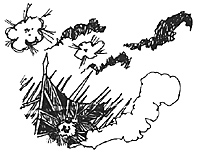 Trudging Through the Peninsula
Trudging Through the Peninsula
Note from Editor: the following short article was published back in 1984 in EE&L 80 (Volume 1) and is so pertinent to the article and comments on Frederick's oblique order that I could not resist in reprinting it.--JL
I have frequently been castigated by Christopher Duffy for trying to study the Napoleonic period without first making a thorough analysis of the eighteen century background. He can clearly see how very much of Napoleonic practice was directly derived from the experiences of the Seven Years' War, the American Revolution, the assorted Russo-Turkish skirmishes, and the rest.
On my part I have always assumed that although all this was was undeniably important, it was somehow the new spirit underlying the Napoleonic style of warfare which made it so different from what went before that one had to concentrate one's effort on Napoleonics themselves.
Today I am not so sure. Joe Park, Gunther Rothenberg and Steve Pratt have each, in their various way, managed to inspire me to look deeply the tactics of the American Civil War. To my surprise I find that the whole thing is distinctly Napoleonic, except that the shakos seem to have got smaller and floppier!
The "military revolution" which we so often read about, and especially the "modernization of tactics", seems to have pretty much evaporated in the glare of close scrutiny. Admittedly you don't often get Murat-style cavalry charges, and the telegraph (occasionally) does manage to short-circuit some of Napoleon's delays in communication: but as far as infantry is concerned the fighting looks remarkably Napoleonic to me. They used cover in just the way that Wellington used it, and they used musketry fire injust the way that the French liked to use it - i.e. indecisively. The length of the firefights was perfectly consistent with the sort of things that seems to have been standard on Napoleon's "Eastern Front", although there were perhaps fewer attempts at a bayonet attack.
On the other hand there were also fewer mass panics than in Napoleonic times. Maybe the general quality of the troops was neither better nor worse, but just "different".
All this leads me to suspect that (once again -- Christopher Duffy is right!) there was no great revolution in Napoleonic times; only a steady evolution. Peter Hofschroer has documented this, I believe, as far as the Prussian drill books of Napoleonic days are concerned. Others have done it for other armies. The implication is that if we want to understand the American Civil War we should have a solid grounding in Napoleonics; and if we want to understand Napoleonics we must have a solid grounding in the wars of Frederick the Great. There is certainly no shortage of people who want to interpret the First World War in terms of the American Civil War - but why are we reluctant to carry the process before that???
Back to Empire, Eagles, & Lions Table of Contents Vol. 2 No. 4
Back to EEL List of Issues
Back to MagWeb Master Magazine List
© Copyright 1994 by Emperor's Headquarters
This article appears in MagWeb (Magazine Web) on the Internet World Wide Web.
Other articles from military history and related magazines are available at http://www.magweb.com
